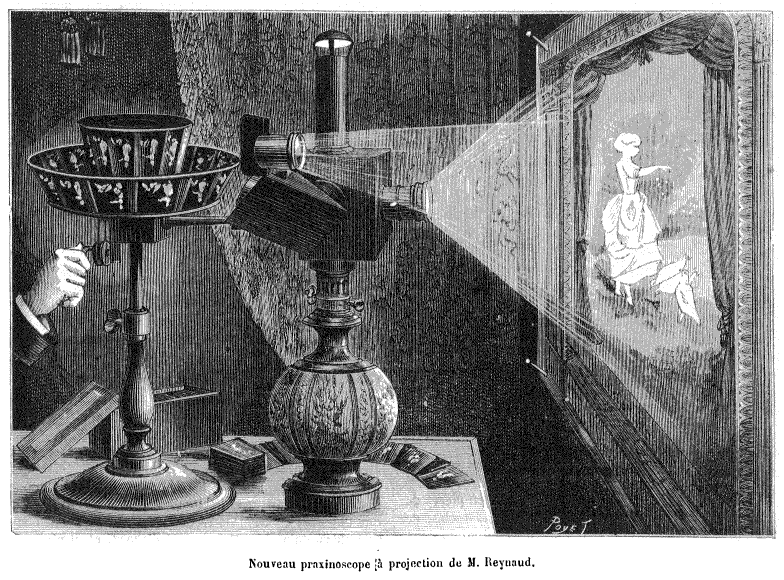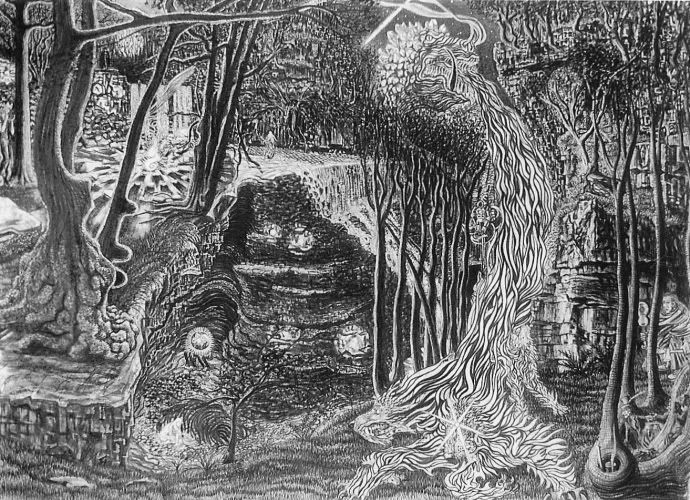I. Draft for a phenakistiscope disc representing a pirouetting dancer
J. Plateau, Corresp. Math. Phys. 1832 VII p.291.

In "Sur un nouveau genre d'illusions d'optique", Plateau describes the construction and the action of a disc with 16 slits and 16 intermediate sectors. When 16 identical drawings are put in the sectors, one sees a stationary image, when looking through the slits at the revolving disc in a mirror.
This is in fact the experiment of Faraday. The brilliant contribution of Plateau comes when in stead of putting 16 identical images in the sectors he draws 16 images, which change little by little.
Because of the visual persistence the images seen in swift succession will fade into each other and a suggestion of movement is created. It is for this reason that Joseph Plateau is cited as the precursor of the movie, more accurately he is the precursor of the animation film.
On 10 December 1830, Michael Faraday(1791-1867) gives a lecture at the Royal Institution. The publication appears in February 1831: "On a peculiar Class of Optical Illusions".
Continuing on what Peter Mark Roget (1779 - 1869) had published in the Philosophical Transactions, he describes two parallel discs, revolving on the same axis, in opposite directions, each having 16 cogs. When viewed in a mirror a stationary image is seen. He does not refer to Plateau's work, done before 1831 and which had been published in the Correspondance mathémathique et physique. Later Faraday writes that the honour is due to Plateau.
II. Peter Mark Roget's 'Palisade' Illusion-.
Peter Mark Roget (1779–1869), author of the famous Thesaurus, first described this illusion, hence known as the 'Roget' or 'Palisade' illusion.
His own explanation is not convincing from our current understanding. Essentially it is a sampling problem. Carpenter detailed a geometrical derivation in 1868, which was recently formalized by Jim Hunt (2003). The intersections of gaps and spokes over time indeed form curves. Due to the afterimage (“persistence of vision”) our perception connects these and we perceive the illusionary shape."
Praxinoscope:
"Praxinoscope"/" Roul'scope"

III. Hybrid Images.
Hybrid images change interpretation as a function of viewing distance. Hybrids combine the low-spatial frequencies of one picture with the high spatial frequencies of another picture producing an image with an interpretation that changes with viewing distance. In this figure, the people may appear sad, up close, but step back a few meters and look at the expressions again.

IV. The Gestalt Effect.

"Amodal perception is the term used to describe the full perception of a physical structure when it is only partially perceived. For example, a table will be perceived as a complete volumetric structure even if only part of it is visible; the internal volumes and hidden rear surfaces are perceived despite the fact that only the near surfaces are exposed to view, and the world around us is perceived as a surrounding void, even though only part of it is in view at any time.
Formulation of the theory is credited to the Belgian psychologist Albert Michotte and Fabio Metelli, an Italian psychologist, with their work developed in recent years by E.S. Reed and the Gestaltists.
Modal completion is a similar phenomena in which a shape is perceived to be occluding other shapes even when the shape itself is not drawn. Examples include the triangle that appears to be occluding three disks in the Kanizsa triangle and the circles and squares that appear in different versions of the Koffka cross."
V. Naïve Realism & Empiricism.
"Historical Context:
Europe had suffered from many centuries of abuse from a totalitarian regime that caused massive regression of the collective consciousness thus giving rise to what is often called “the dark ages”. This began when the Roman empire co-opted the mystic teachings of a small but powerful Christian sect and reinterpret their subtle analogies in purely naïve realist, materialist terms.
By taking certain analogies literally they created a fictional supernatural order that was only accessible via the Church. This was in order to create a politicized state religion to revitalise the crumbling empire and to defuse the growing mystic revolution that was under way. "
VI. Altered Consciousness.
The Mind in the Cave: Consciousness and the Origins of Art.
"When, in 1879, Don Marcelino Sanz de Sautuola discovered the astonishing paintings of bison in his cave at Altamira, his claim that they were of prehistoric origin was ridiculed. The breathtakingly accomplished images were impossible to square with the prevailing image of Ice Age ’savages’, and he died discredited as a hoaxer.
In the century since the cave art of the Palaeolithic has been accepted as genuine, it’s suffered the opposite fate. It’s clearly so important a clue to the origins of human culture that interpreting it has come to involve impossibly weighty questions. Does it reveal the first human religion and, if so, what was it? Was it an individual or communal enterprise? Was it devotional, ritual, practical, or ’simply decorative’ (whatever that may mean)?
Does it locate the roots of human culture in totemism, or sympathetic magic, or initiation rites? The cumulative effect of all the grand theories in the first half of the twentieth century was to turn the cave paintings into a kind of Rorschach ink blot test, where every theorist saw their own version of human genesis revealed.
Structuralism was the last grand attempt at a definitive decoding of cave art, but its overarching theory that the paintings mediated binary oppositions left many specifics and anomalies unaccounted for. Since then, scholars have tended to fight shy of the big questions, and limit their researches to accumulating ever more detailed analyses of paint scrapings and cross-hatching techniques. But David Lewis-Williams has had enough of this.
In his view, either there’s now enough evidence to interpret the images, or else there’s never going to be enough. In either case, it’s time to attempt another big theory, one which he compares in scope to Darwin’s: not a closed, provable theorem but an explanatory framework which accounts for multiple unrelated phenomena and opens up scope for further discovery.
Those familiar with his previous work on African San (’Bushman’) rock art and altered states of consciousness will have some idea of his basic trajectory, but in The Mind in the Cave he travels further and deeper."
Cave of Lascaux.
VII. Quantum Physics & Naive Realism.
The Observer effect.
"It is this reflection in the mirror of memory that gives us that sense of "I- ness" namely, a pattern of habits, a pattern of memories, patterns of the past, all of our meanings of "who I am" come from this mirror of reflection." "The illusion will only be cleared up when we are prepared to work a little, we have to work our way back to this freedom, to this consciousness....." Amit Goswami.
Jeff Wall.
VIII. Optical Illusions & Patterns.











IX. Why Social-Cognitive Neuroscience?
"Social cognition and cognitive neuroscience are independent academic disciplines that interact sparingly. There are at least three reasons why neither discipline can afford this independence.
First, the brain is an evolutionary adaptation to a social environment and is best understood in that context. Second, human brains interact with other human brains in a complex social network that produces phenomena that cannot be reduced. And finally, complete explanations of behavior always require multiple levels of analysis."
X. Pattern Recognition.
"People love patterns. Our brains readily organize the stream of information from our senses to find pattern, structure and connections. Our pattern-finding ability lets us understand the world in front of us; sometimes it fools us with optical illusions.
For a growing number of researchers at UC Davis, pattern recognition is a fast-growing field of science where disciplines like computer science, statistics, biology and physics converge.
From genetics labs to astronomers' observatories, scientists are being flooded with data. There is a need to develop tools to process data very quickly, so humans can make use of it in real time, and to analyze it for increasingly subtle connections.
"We rely on pattern analysis so much as a society, but haven't stopped to think about its principles," said Nello Cristianini, associate professor of statistics at UC Davis."
Everything, is real.
"The world is merely fire reflected in our eyes."
Quote by, Amy M Denes.





